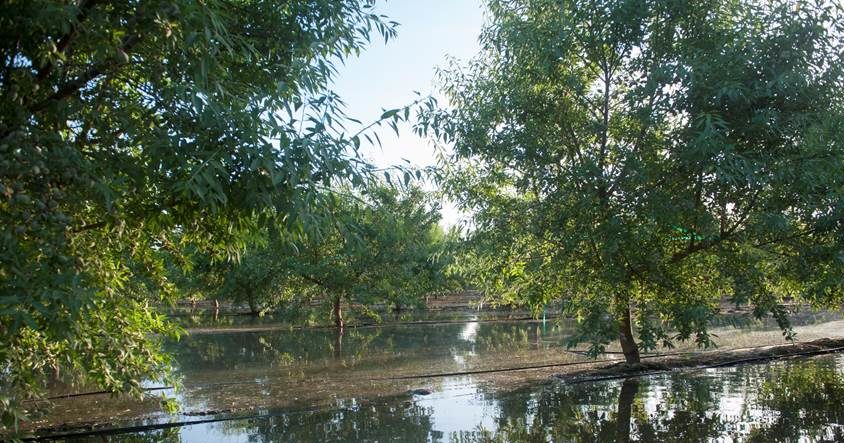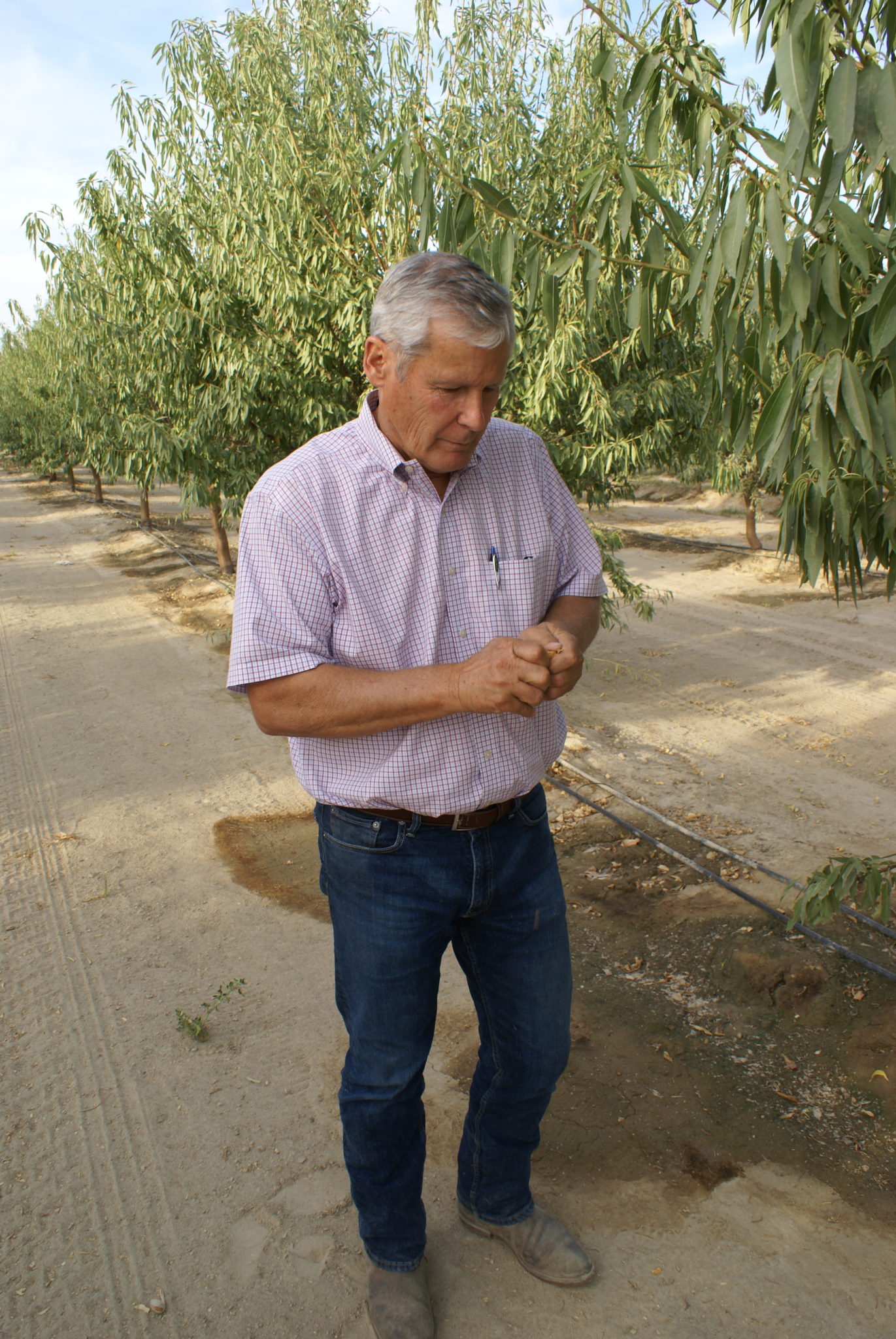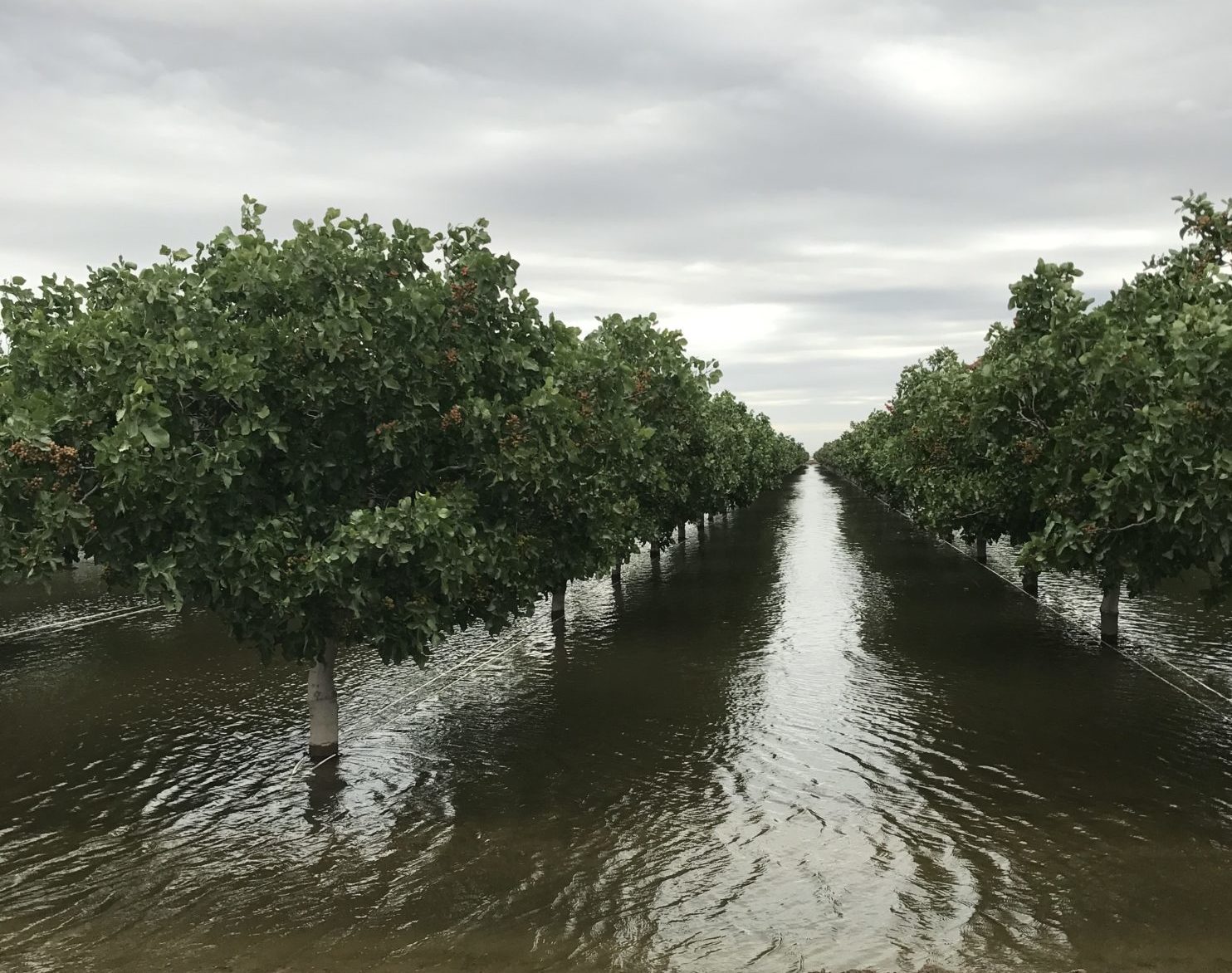
Ten years ago was a time before the Sustainable Groundwater Management Act, and even before many knew what ‘white lands’ were. It was also a time when a Central Valley farmer and an innovator in groundwater recharge had the foresight to start thinking about the future of aquifers on a large scale.
On-farm groundwater recharge is defined as “taking advantage of the water capture, filtration and storage services provided by natural and working landscapes,” according to the University of California, Agriculture and Natural Resources study titled Supporting sustainable groundwater management.
Growers are turning to on-farm recharge to replenish the aquifer below their orchards and capture floodwater that otherwise would be lost. This is not a new concept to Don Cameron, general manager of Terranova Ranch, located in Helm, California.
“In an area that relies entirely on groundwater, I figured pretty early on we needed to correct the problem,” Cameron said. “We were losing 2 feet of groundwater elevation a year due to pumping. We needed to do something if we wanted to continue to farm.”
Terranova is mostly located within the ‘white lands,’ now a common reference to non-districted land or land that is entirely reliant on groundwater with no access to surface water.
Putting Excess Surface Water To Work
Cameron has been working on projects to capture floodwater off the Kings River alongside other local growers for more than 30 years.
In the first year of the project, Cameron was able to capture 5,000-acre-feet of floodwater off the North Fork of the Kings River and began flooding wine grape vineyards for groundwater recharge.
“We proved in 2011 we could grow vineyards without harming them and get water into the ground for recharge,” he said.
Cameron then received a Floodwater Corridor grant from the California Department of Water Resources through the Kings River Conversation District in 2011 to install 4 miles of canals, pumping stations, flood gates and crossings to develop the beginning of the real backbone to phase 1 of his recharge project. The grant funded the process of connecting to flood water access points. Prior to that, Cameron had no connection to surface water. The project also includes 400 aces of flood basins that are farmed in dry years with row crops.
In wet years, after the surrounding water districts are satisfied with their allotment, Cameron can capture and recharge with the balance. “Water Districts take what they want and need. When the state has a heavy snowpack year and full reservoirs, our farm can take what would otherwise head out to the ocean,” Cameron explained.
The completed first phase of the groundwater recharge project supports 6,000 acres and is designed to expand to the neighbors to include 18,000 acres in total. “With the capacity of 1,000-acre-feet a day of floodwater, the mission of the project is taking flood water off the Kings River to protect downstream damage to local communities and at the same time use that water for groundwater recharge.”
In 2017 Cameron expanded from flooding wine grapes to experimenting with flooding pistachios, almonds, olives, and other vineyard blocks on their ranch.
“One vineyard block, we were able to put 13-acre-feet of water on and move the water below the ground. We keep experimenting with different crops and see what we can do.” Cameron said. “In 2017, we were able to take another 5,000-acre-foot of floodwater. Our monitors on our wells showed the groundwater levels increase. We know we are making a difference.”

Interest in Groundwater Recharge
Growers across the state have begun thinking the same way about how they can make a difference by investing in groundwater recharge on their farms. Greg Wegis, a partner with Wegis & Young, installed a tile drain system in the spring of 2018. Prior to planting a 40-acre almond orchard in Wasco, Wegis worked with a specialized construction group to install a tile drain system under the new planting. He installed a series of 4-inch corrugated perforated pipe 8.5 feet deep every 96 feet. It took two to three weeks and roughly $2,500 per acre to install the tile drain system.
The construction group Wegis used has been installing these drains in the Imperial Valley for years, but reversing the idea in the Central Valley. Dana Munn, general manager of Shafter-Wasco Irrigation District, has been researching and implementing recharge and banking projects for most of his water career. He explained that the tile drains are “nothing new to the water world. But we are making them flow in reverse as what they have traditionally been used for. Usually, a tile drain was used to drain excess water off a piece of land. Now we are trying to keep excess water and store it below ground.”
Wegis was able to use the existing filter station to help filter water and send it through a standpipe, which uses gravity flow to distribute into the tile systems. There is a rock ring layer around the corrugated pipe to keep it free from plugging with foreign material or excess silt. The orchard was then planted on top of the tile drain and farmed normally.
As with Terranova’s project, Wegis’ system operates on water availability in wet years. Utilizing a smaller system, Wegis can recharge with lower risk, all while continuing to farm.
“The tile drain is designed between the tree rows, and as far away from the root zone as possible. We don’t want the trees to uptake the moisture. We want that moisture being percolated and recharged,” Wegis said.
Almonds’ shallow roots make it an ideal crop for the deep 8.5-foot-deep tile drain.
“There are monitoring wells 10 feet deep to ensure water is used for recharge, not irrigation,” Wegis said.
Wegis has a relationship with Semitrophic Water Storage District for purchasing flood water and utilizing district water for on-farm recharge projects. Utilizing Article 21 water, Wegis can keep 90 percent of the recharge water with the balance going to the district.
“In the end, recharging with tile drains ultimately is aiding the district as well as the grower,” he said.
Water Districts across the valley are looking for innovative ideas to solve the groundwater problem and are encouraged to see more landowners dedicated to recharge projects.
“Currently in our district, we are working with on-farm recharge, not flooding recharge projects as you may see up north. We focus on landowner dedicated recharge ponds and farmers who are implementing below ground tile drain systems,” Munn said.
Munn is reassured to see landowners develop their own projects that aid in recharge as well as keep farmland in production. When projects allow a farmer to continue to farm as well as recharge, it is a win, he said.
“SWID’s goal is simple. We aim to balance our water budget so your farm can be uninterrupted.”

Waiting for the Opportunity to Recharge
In the Central Valley, there is not always the capability for utilizing recharge.
“One out of every four years is wet,” Munn said. “In that one year, you have three to four months of recharge opportunities with one month of prime utilization time.”
As a result, for growers like Cameron and Wegis, their projects will not be productive every year. Cameron had a series of four years during the drought where he couldn’t store any water. Wegis wasn’t able to utilize his system until year two because of water availability. The idea is to have the systems there for wet years and to take advantage of surplus off-season water that would otherwise be lost.
The projects may sound simple but they—and the grant process—can come with challenges. Even before a 40-acre project can begin, a landowner needs to prove the project will work for recharge. Wegis had to drill a 50-foot core sample to fully categorize the soil types. Determining sand or clay type soils will help engineers and districts involved calculate the effectiveness and structure needed for the project.
“There can be limitations by pipeline distribution capacity in the area,” Munn explained. “Irrigation deliveries will always come first. Recharge projects will receive water when capacity is available. Come late winter and early spring and into summer, the run-off period is prime to use.”
There are multiple factors landowners need to evaluate when considering whether recharge projects may work for them.
“The geography and geology of your basin is a huge element before you start a project,” Munn said. “Utilization of water in-district or land contiguous to another interconnecting district is a factor. Landowners can be limited to where water credits can move. Understanding the costs of the projects and whether grants, landowners or districts will cover costs.”
Landowners and water districts more and more are evaluating project ideas and concerns together to find projects that can work for individual situations.
Cameron said the stakes are high for getting it right to help improve the groundwater situation before regulations make it impossible to farm in affected areas.
“It is our hope to correct some of our overdraft. We have 20 years to figure this out and our project will be key. The last thing any of us want is to idle farmland. The growers in our areas are committed to finding a solution to overdraft.”










